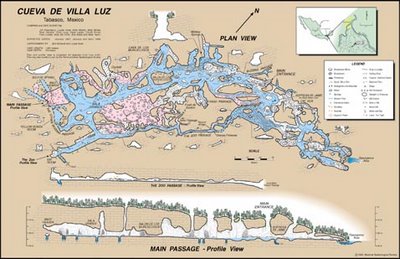The Buzz
Penny Boston – a professor at New Mexico Tech who once spent two weeks "in a self-contained 24-foot-diameter capsule in the Utah desert to simulate working conditions on Mars" – has also discovered a cave tunnel that buzzes.
 [Image: The Cueva de Villa Luz, Mexico, with its buzzing tunnel; see also this PDF for more information, or this site for more images].
[Image: The Cueva de Villa Luz, Mexico, with its buzzing tunnel; see also this PDF for more information, or this site for more images].
"Drops of sulfuric acid from the ceiling sting my neck and back as I crawl," Boston explains in an old issue of Wired. "I can hear something far down the narrow tunnel," she writes, "a buzzing like a million tiny voices. My team members and I don't know what it is. We've tried to find out, but each time something forces us to turn back: a spike in carbon monoxide, a breathing-mask failure, a choking blast of ammonia. Now I'm trying again. But the passage is narrowing."
The buzzing tunnel there in front of her is the Cueva de Villa Luz system, in Mexico. These deep, chemically exotic subterranean environments, Boston believes, are excellent examples of the landscapes that might host life beyond Earth – on Mars, for example.
In fact, Boston continues, "since first suggesting that the underworld was a good Mars analog in 1992, my team has studied caves filled with microorganisms that eat bedrock and produce unique minerals, and we've found beautiful crystal formations that are products of ancient subterranean life. I've dived into hot acid waters, rappelled into deep pristine caves where no humans have gone before. In these worlds under the water, we are the aliens, barely able to cope, while the natives happily flourish." These "natives" are called extremophiles: micro-organisms capable of surviving almost literally infernal conditions.
They're not cute little animals, however; these organisms are often described as a kind of sticky cave-snot – thick sheets of living mucus.
Boston: "The debate about whether there actually is life anywhere else in our solar system has raged for the past century. We just don't know – but someday we'll go find out. We'll face many of the same dangers and challenges we do while exploring the subsurface of our own planet." In the meantime, she adds, "the caves of the solar system await us." Such as the caves of Mars.
And yet, fascinatingly, Boston and her research team "still don't know" why that tunnel, deep in Mexico, was buzzing...
[Note: At least one other landscape in Mexico has U.S. scientists convinced they've found biological analogs for alien life; you can read about the marshes of Cuatro Ciénegas here on BLDGBLOG. Meanwhile, Penny Boston has some interesting ideas for how to terraform Mars – how to prepare it for supporting life – and this includes cultivating huge ponds of duckweed].
 [Image: The Cueva de Villa Luz, Mexico, with its buzzing tunnel; see also this PDF for more information, or this site for more images].
[Image: The Cueva de Villa Luz, Mexico, with its buzzing tunnel; see also this PDF for more information, or this site for more images]."Drops of sulfuric acid from the ceiling sting my neck and back as I crawl," Boston explains in an old issue of Wired. "I can hear something far down the narrow tunnel," she writes, "a buzzing like a million tiny voices. My team members and I don't know what it is. We've tried to find out, but each time something forces us to turn back: a spike in carbon monoxide, a breathing-mask failure, a choking blast of ammonia. Now I'm trying again. But the passage is narrowing."
The buzzing tunnel there in front of her is the Cueva de Villa Luz system, in Mexico. These deep, chemically exotic subterranean environments, Boston believes, are excellent examples of the landscapes that might host life beyond Earth – on Mars, for example.
In fact, Boston continues, "since first suggesting that the underworld was a good Mars analog in 1992, my team has studied caves filled with microorganisms that eat bedrock and produce unique minerals, and we've found beautiful crystal formations that are products of ancient subterranean life. I've dived into hot acid waters, rappelled into deep pristine caves where no humans have gone before. In these worlds under the water, we are the aliens, barely able to cope, while the natives happily flourish." These "natives" are called extremophiles: micro-organisms capable of surviving almost literally infernal conditions.
They're not cute little animals, however; these organisms are often described as a kind of sticky cave-snot – thick sheets of living mucus.
Boston: "The debate about whether there actually is life anywhere else in our solar system has raged for the past century. We just don't know – but someday we'll go find out. We'll face many of the same dangers and challenges we do while exploring the subsurface of our own planet." In the meantime, she adds, "the caves of the solar system await us." Such as the caves of Mars.
And yet, fascinatingly, Boston and her research team "still don't know" why that tunnel, deep in Mexico, was buzzing...
[Note: At least one other landscape in Mexico has U.S. scientists convinced they've found biological analogs for alien life; you can read about the marshes of Cuatro Ciénegas here on BLDGBLOG. Meanwhile, Penny Boston has some interesting ideas for how to terraform Mars – how to prepare it for supporting life – and this includes cultivating huge ponds of duckweed].





Comments are moderated.
If it's not spam, it will appear here shortly!
Post a Comment